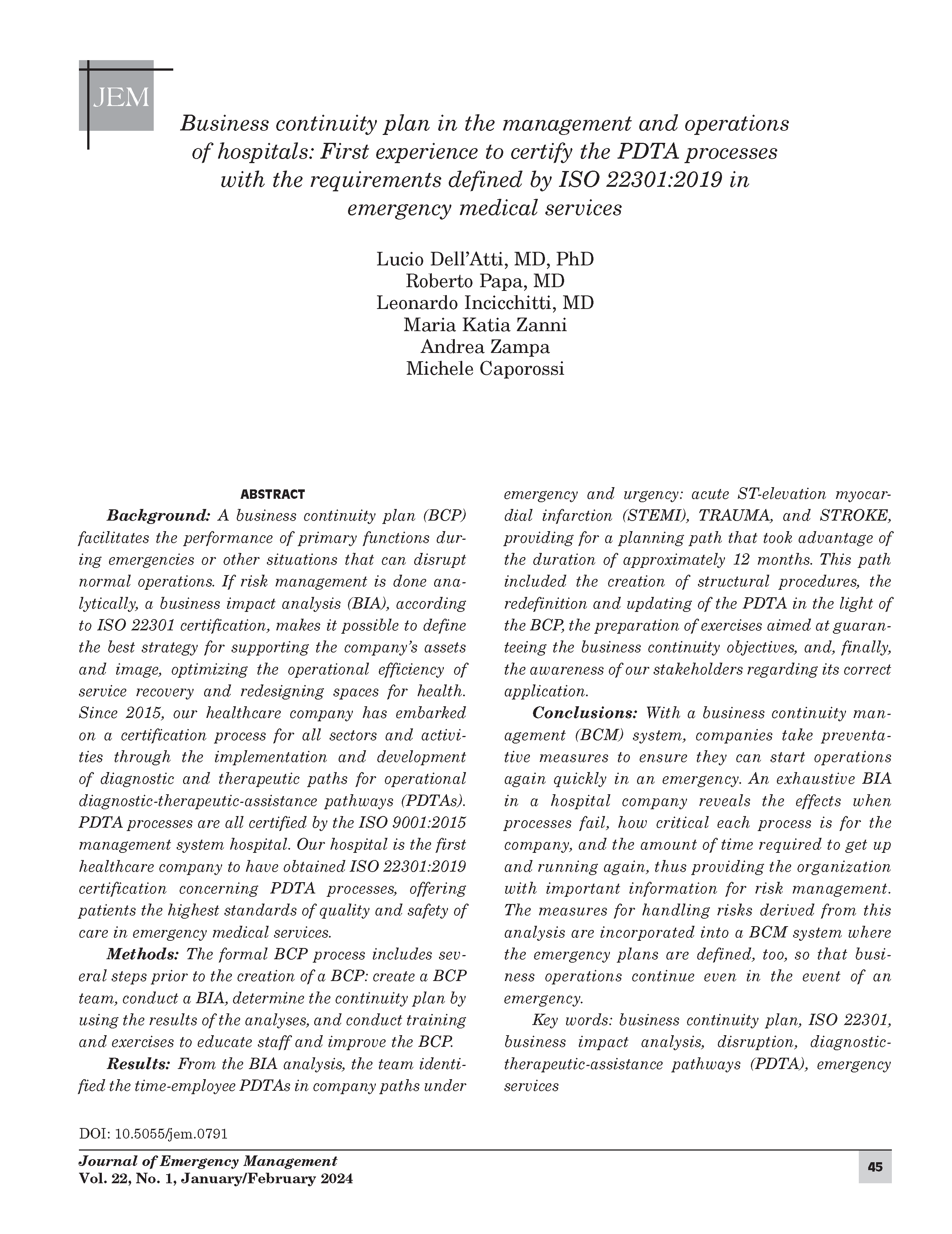Business continuity plan in the management and operations of hospitals: First experience to certify the PDTA processes with the requirements defined by ISO 22301:2019 in emergency medical services
DOI:
https://doi.org/10.5055/jem.0791Keywords:
business continuity plan, ISO 22301, business impact analysis, disruption, diagnostic-therapeutic-assistance pathways (PDTA), emergency servicesAbstract
Background: A business continuity plan (BCP) facilitates the performance of primary functions during emergencies or other situations that can disrupt normal operations. If risk management is done analytically, a business impact analysis (BIA), according to ISO 22301 certification, makes it possible to define the best strategy for supporting the company’s assets and image, optimizing the operational efficiency of service recovery and redesigning spaces for health. Since 2015, our healthcare company has embarked on a certification process for all sectors and activities through the implementation and development of diagnostic and therapeutic paths for operational diagnostic-therapeutic-assistance pathways (PDTAs). PDTA processes are all certified by the ISO 9001:2015 management system hospital. Our hospital is the first healthcare company to have obtained ISO 22301:2019 certification concerning PDTA processes, offering patients the highest standards of quality and safety of care in emergency medical services.
Methods: The formal BCP process includes several steps prior to the creation of a BCP: create a BCP team, conduct a BIA, determine the continuity plan by using the results of the analyses, and conduct training and exercises to educate staff and improve the BCP.
Results: From the BIA analysis, the team identified the time-employee PDTAs in company paths under emergency and urgency: acute ST-elevation myocardial infarction (STEMI), TRAUMA, and STROKE, providing for a planning path that took advantage of the duration of approximately 12 months. This path included the creation of structural procedures, the redefinition and updating of the PDTA in the light of the BCP, the preparation of exercises aimed at guaranteeing the business continuity objectives, and, finally, the awareness of our stakeholders regarding its correct application.
Conclusions: With a business continuity management (BCM) system, companies take preventative measures to ensure they can start operations again quickly in an emergency. An exhaustive BIA in a hospital company reveals the effects when processes fail, how critical each process is for the company, and the amount of time required to get up and running again, thus providing the organization with important information for risk management. The measures for handling risks derived from this analysis are incorporated into a BCM system where the emergency plans are defined, too, so that business operations continue even in the event of an emergency.
References
Capparelli J, Chionna G, Riglietti G: What makes for effective business continuity implementation? J Bus Contin Emer Plan. 2022; 15(4): 302-311.
Zawada B: The practical application of ISO 22301. J Bus Contin Emer Plan. 2014; 8(1): 83-90.
Tozzi VD: Process management and PDTA: Some reflections. Recenti Prog Med. 2021; 112(2): 140-145.
Sever MS, Remuzzi G, Vanholder R: Disaster medicine and response: Optimizing life-saving potential. Am J Disaster Med. 2018; 13(4): 253-264.
Hidalgo J, Baez AA: Natural disasters. Crit Care Clin. 2019; 35(4): 591-607.
Suginaka H, Okamoto K, Hirano Y, et al.: Hospital disaster response using business impact analysis. Prehosp Disaster Med. 2014; 29(6): 561-568.
Ee H: Business continuity 2014: From traditional to integrated business continuity management. J Bus Contin Emer Plan. 2014-2015; 8(2): 102-105.
Stevenson JR, Brown C, Seville E, et al.: Business recovery: An assessment framework. Disasters. 2018; 42(3): 519-540.
Berry LL, Awdish RLA: Health care organizations should be as generous as their workers. Ann Intern Med. 2021; 174(1): 103-104.
Bessis S, Dinh A, Gautier S, et al.: A restructured hospital into a one-building organization for COVID-19 patients: A resilient and effective response to the pandemic. Front Public Health. 2022; 10: 709848.
Borms L, Brusselaers J, Vrancken KC, et al.: Toward resilient organizations after COVID-19: Analysis of circular and less circular companies. Resour Conserv Recycl. 2023; 188: 106681.
Piccinni C, Calabria S, Ronconi G, et al.: Facts and figures of clinical pathways in Italy: Results from the PDTA net project. Recenti Prog Med. 2019; 110(4): 188-194.
Bokolo Anthony J: Use of telemedicine and virtual care for remote treatment in response to COVID-19 pandemic. J Med Syst. 2020; 44(7): 132.
Lindstedt D: Estimated value realisation: A comparison between standard and adaptive business continuity approaches. J Bus Contin Emer Plan. 2020; 14(2): 153-177.
Snedaker S (ed.): Business Continuity and Disaster Recovery Planning for IT Professionals. Amsterdam: Elsevier, 2013.
Elliott D, Herbane B, Swartz E (ed.): Business Continuity Management. London: Routledge, 2001: 16.
Khorram-Manesh A, Phattharapornjaroen P, Mortelmans LJ, et al.: Current perspectives and concerns facing hospital evacuation: The results of a pilot study and literature review. Disaster Med Public Health Prep. 2022; 16(2): 650-658.
Parnell A, Goniewicz K, Khorram-Manesh A, et al.: COVID-19 a health reform catalyst? Analyzing single-payer options in the US: Considering economic values, recent proposals, and existing models from abroad. J Hosp Adm. 2020; 9(4): 10-19.

Published
How to Cite
Issue
Section
License
Copyright 2007-2025, Weston Medical Publishing, LLC and Journal of Emergency Management. All Rights Reserved.





